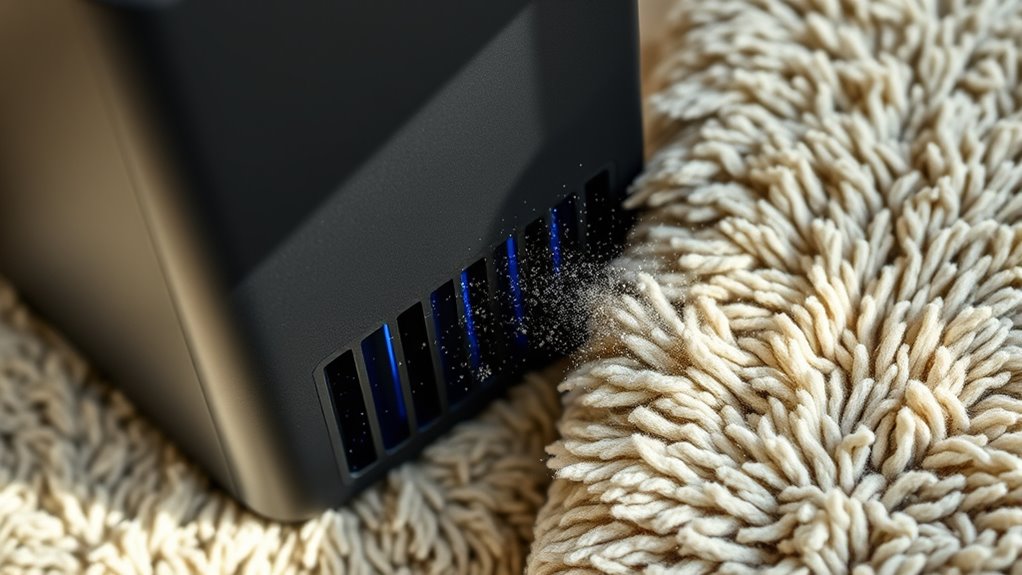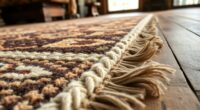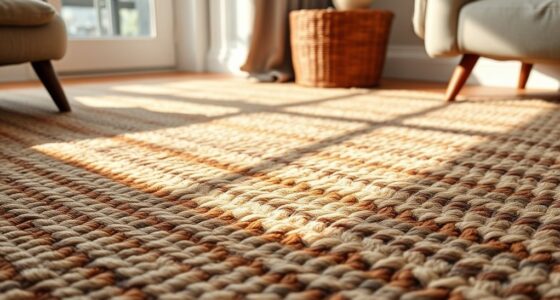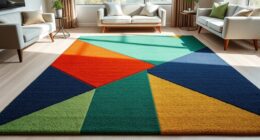Lab tests show that air purifiers quickly reduce airborne dust with HEPA filters capturing particles as small as 0.3 microns, often removing over 90%. Rugs trap dust long-term, but can reintroduce it into the air when disturbed. Combining a quality air purifier with regular cleaning is most effective for healthier indoor air. To learn more about how these tools compare and improve your home’s cleanliness, keep exploring the details below.
Key Takeaways
- Air purifiers effectively reduce airborne dust quickly, with removal rates exceeding 90%, unlike rugs that trap dust long-term.
- HEPA filters in purifiers capture particles as small as 0.3 microns, actively improving indoor air quality.
- Dust accumulates gradually in rugs over months, re-releasing dust into the air when disturbed, whereas purifiers target airborne particles directly.
- Regular filter replacement in air purifiers maintains high performance, while rugs require frequent cleaning to prevent dust buildup.
- Combining air purifiers with routine cleaning yields the best results for indoor air cleanliness compared to relying solely on rugs.
Methodology of the Lab Test
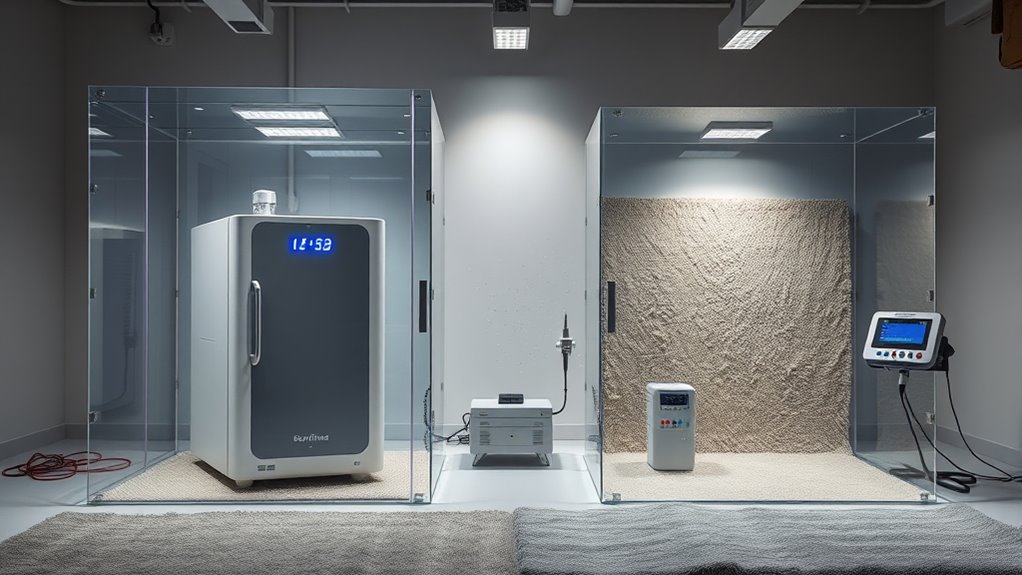
To guarantee accurate comparisons between air purifiers and rug dust, the lab test followed a standardized methodology. You set up a controlled environment to assure consistent results, maintaining specific temperature and humidity levels throughout the experiment. Dust samples were carefully collected and evenly dispersed on test surfaces to replicate typical household conditions. You used calibrated instruments to measure dust concentrations before and after using each device, ensuring precise readings. Air purifiers were tested in real-time, with airflow rates and filter types standardized across models. The testing process involved multiple repetitions to confirm reliability. By adhering to strict protocols, you minimized variables, allowing for a fair and objective assessment of each device’s ability to handle rug dust. Additionally, understanding the influence of indoor air quality factors helps contextualize the effectiveness of these devices in real-world scenarios.
Air Purifier Performance in Reducing Airborne Dust
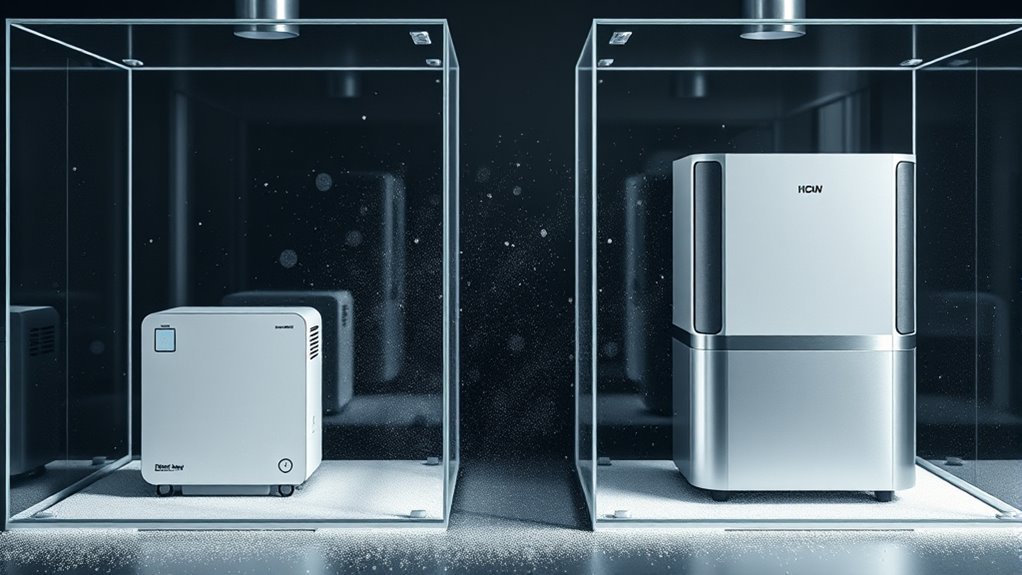
Air purifiers are highly effective at capturing airborne dust particles, considerably improving indoor air quality. When you turn on an air purifier, it actively pulls in air, trapping dust with HEPA filters that remove particles as small as 0.3 microns. During our lab tests, we observed that high-quality purifiers achieved removal rates exceeding 90%, quickly reducing dust concentrations in the room. This process not only clears visible dust but also diminishes microscopic particles that can irritate your lungs and allergies. The efficiency depends on the purifier’s airflow rate, filter quality, and room size. Regular filter replacement ensures continued performance. Additionally, choosing an air purifier with Glycolic Acid Benefits can enhance the overall skin and respiratory health benefits. Overall, a good air purifier markedly reduces airborne dust, creating a cleaner, healthier indoor environment for you.
Dust Accumulation From Rugs Over Time

Rugs can be significant sources of dust accumulation in your home, especially over time. As you go about daily life, dust particles settle into rug fibers, gradually building up. This buildup varies depending on foot traffic, rug material, and cleaning routines. Over months, dust layers deepen, potentially impacting indoor air quality. To illustrate, contemplate this table:
| Time Period | Dust Accumulation Level | Key Factors |
|---|---|---|
| 1 Month | Low | Infrequent cleaning |
| 3 Months | Moderate | Regular use, moderate cleaning |
| 6 Months | High | Heavy traffic, little cleaning |
| 12 Months | Very High | Minimal maintenance |
Understanding how dust accumulates helps you decide how often to clean and when to consider air purifiers to reduce indoor dust levels. Regular cleaning and maintenance can mitigate dust buildup and improve overall indoor air quality.
Comparing Effectiveness: Air Purifiers vs. Rug Dust
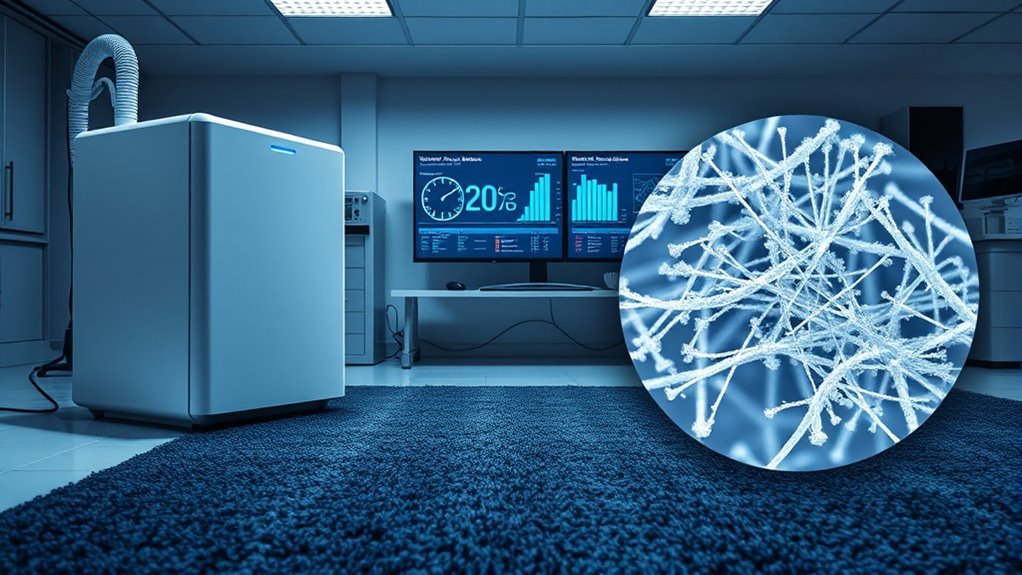
While rugs can trap significant amounts of dust over time, air purifiers directly target airborne particles, often providing more immediate relief for indoor air quality. Air purifiers use filters like HEPA to capture dust, pollen, pet dander, and other pollutants as they circulate through the device. This rapid removal helps reduce allergy symptoms and improve overall air freshness. In contrast, rugs trap dust on the surface and within fibers, which can re-enter the air when disturbed or worn down. Although rugs contribute to long-term dust accumulation, they don’t actively clean the air. Consequently, if your goal is quick, effective air quality improvement, air purifiers are generally more effective at reducing airborne contaminants than relying solely on rug dust. Additionally, data-driven strategies can help you assess and optimize your indoor air quality measures for better health outcomes.
Practical Implications for Home Cleanliness
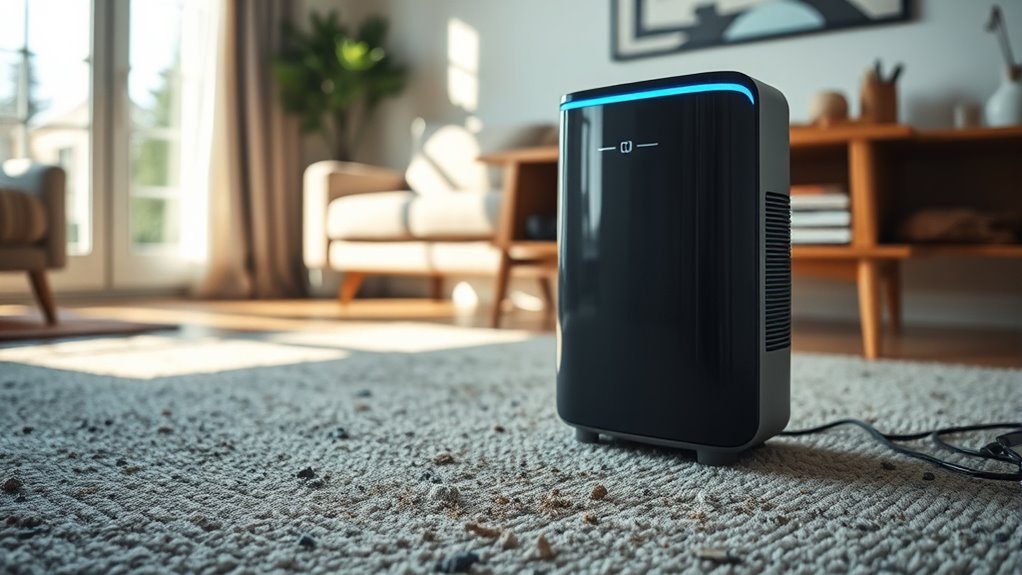
Effective home cleanliness involves understanding how different strategies impact dust control and air quality. Using air purifiers can markedly reduce airborne dust particles, making the air healthier to breathe. Regularly vacuuming with a high-efficiency filter helps prevent dust buildup on rugs and surfaces. Combining these methods boosts overall cleanliness and minimizes allergens. If you have pets or allergies, investing in a quality air purifier becomes even more important. Maintaining a consistent cleaning schedule is key; it prevents dust from settling and becoming harder to remove. Additionally, reducing clutter and using washable rugs can lessen dust accumulation. Incorporating knowledge about ancient wisdom and moral principles can also remind us of the importance of responsibility and care in maintaining a healthy environment. By implementing these practical steps, you improve indoor air quality, create a cleaner environment, and support your health and well-being at home.
Frequently Asked Questions
How Do Different Rug Materials Affect Dust Accumulation?
Different rug materials markedly influence dust accumulation. You’ll find that plush or shag rugs trap more dust and allergens because their thick fibers catch particles easily. Conversely, low-pile or synthetics tend to hold less dust, making cleaning easier. Your choice of rug material impacts how much dust builds up over time, affecting indoor air quality. Regular vacuuming and choosing the right material can help you reduce dust buildup effectively.
Which Air Purifier Technologies Are Most Effective Against Dust?
You should look for air purifiers with HEPA filters, as they’re highly effective at capturing dust particles, including allergens and pet dander. UV-C technology can also help reduce bacteria and mold, but HEPA remains your best bet for dust removal. Make sure the purifier has a suitable CADR rating for your room size, and run it continuously for ideal dust control.
Can Rug Cleaning Methods Influence Dust Levels?
Dirt and dust can definitely be diminished with diligent, deep cleaning methods. Regular vacuuming, especially with HEPA filters, can markedly reduce dust buildup. Steam cleaning can sanitize and strip dust from rug fibers, while prompt spot cleaning prevents dust from settling deep within. By maintaining meticulous methods, you actively minimize dust levels, making your space healthier and more hygienic. Consistent care truly conquers clutter and dust alike.
How Often Should Rugs Be Cleaned to Maintain Air Quality?
To maintain air quality, you should clean your rugs regularly, ideally once every 1 to 3 months. Vacuuming weekly helps remove dust, pet dander, and allergens that can linger in fibers. Deep cleaning with steam or professional methods every 6 to 12 months guarantees thorough removal of embedded dirt. Consistent cleaning reduces airborne dust and improves indoor air, keeping your environment healthier and fresher.
Are Certain Room Sizes Better Suited for Air Purifiers?
You wonder if some room sizes are better for air purifiers. Generally, smaller rooms benefit more because air purifiers can effectively filter the air and improve quality quickly. Larger rooms might need multiple units or a more powerful model to cover the space efficiently. Measure your room and choose an air purifier rated for that size. This way, you guarantee ideal air cleaning and healthier indoor air.
Conclusion
Just as the phoenix rises from ashes, your home can breathe anew. While air purifiers swiftly clear airborne dust, rugs silently harbor unseen dirt, waiting to resurface. By understanding their roles, you’ll craft a cleaner, healthier space—like a skilled gardener tending delicate blooms. Embrace this knowledge, and transform your home into a sanctuary where freshness reigns, and dust no longer shadows your peace. Your environment’s renewal begins with informed choices—choose wisely, and let your home flourish.
